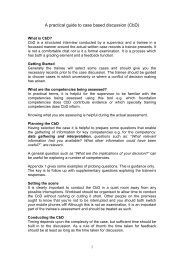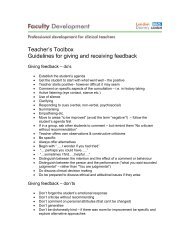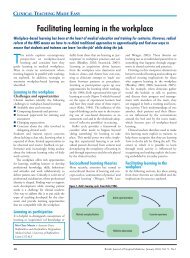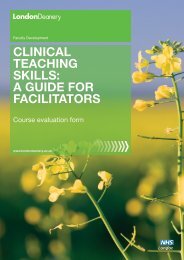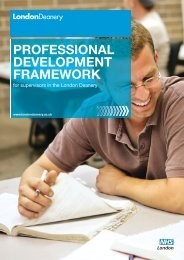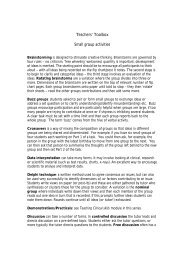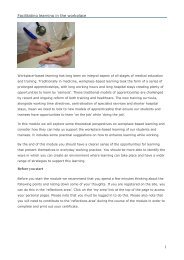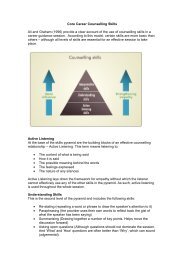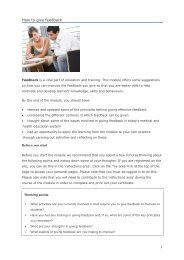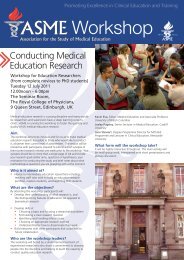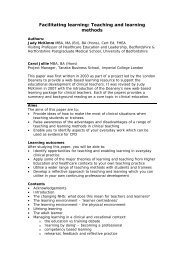A GuIdE for fACILITATorS - Faculty Development - London Deanery
A GuIdE for fACILITATorS - Faculty Development - London Deanery
A GuIdE for fACILITATorS - Faculty Development - London Deanery
You also want an ePaper? Increase the reach of your titles
YUMPU automatically turns print PDFs into web optimized ePapers that Google loves.
<strong>Faculty</strong> <strong>Development</strong><br />
CLINICAL<br />
TEACHING<br />
SKILLS:<br />
A guide <strong>for</strong><br />
FACILITATORS<br />
Notes <strong>for</strong> facilitators<br />
www.londondeanery.ac.uk
Clinical Teaching Skills:<br />
A GUIDE FOR FACILITATORS<br />
notes <strong>for</strong> Facilitators<br />
Introduction to THE NOTES FOR facilitators<br />
This course has been designed to enable clinicians to learn how to<br />
apply education theory to their own clinical and teaching practice.<br />
The course uses participatory approaches which encourage<br />
collaboration and reflection among participants, enabling key<br />
challenges <strong>for</strong> clinical teaching to be explored and strategies to<br />
address challenges to be identified.<br />
About this guide<br />
The purpose of this brief guide is to help you facilitate the clinical<br />
teaching skills workshops. Contained within it should be all the<br />
in<strong>for</strong>mation that you need to run the workshop on the day. The<br />
notes contain copies of the slides that are provided with the<br />
course. The slides and notes suggest approaches to sessions.<br />
However, you may decide not to use some of the slides and may<br />
use instead slides or activities that you develop <strong>for</strong> individual<br />
sessions.<br />
Preparation<br />
Prior to running their own course it is recommended that facilitators<br />
attend a workshop as an observer, and during that day annotate a<br />
copy of this guide. Ideally, this course is delivered by two facilitators<br />
working together throughout the day, although it is possible <strong>for</strong> the<br />
day to be delivered by one facilitator.<br />
This guide should also be seen as a ‘starter <strong>for</strong> 10’ – a way of<br />
getting going. But it is not intended to be narrowly prescriptive.<br />
Workshop facilitators will probably have their own examples from<br />
practice that will be useful to the groups they work with.<br />
The NHS Institute <strong>for</strong> Innovation and Improvement has developed<br />
two guides that can be used in conjunction with the facilitators’<br />
notes to help you think about how you would like to deliver this<br />
course and how you may adapt your delivery after you have run<br />
the course several times. ‘A Handy Guide to Facilitation’ provides<br />
guidance on facilitating groups and workshop. ‘The Facilitators’<br />
Tool Kit’ which contains ‘tools, techniques and tips’ <strong>for</strong> those<br />
who are new to facilitation. (NHS Institute <strong>for</strong> Innovation and<br />
Improvement 2009a,b).<br />
Both guides can be accessed via the following link:<br />
www.institute.nhs.uk/fundamentals<br />
The facilitator role<br />
It is essential that this role is one of facilitation and not that of a<br />
lecturer. It is not essential to have expert knowledge of the topic.<br />
What is essential in a facilitator of this workshop are<br />
the following.<br />
• A robust understanding of clinical teaching practices.<br />
• Knowledge of clinical teaching theory.<br />
• The ability to draw effectively on the experience within<br />
the group, in order to make full use of the knowledge and<br />
understanding that different participants bring to the workshop.<br />
• The ability to present clearly the different activities contained<br />
with the workshop and manage the time effectively so that the<br />
necessary material is covered.<br />
• The confidence, if necessary, to challenge participants if they<br />
are unduly cynical about educational supervision or about wider<br />
changes in medical education.<br />
The course<br />
Purpose<br />
This course has been designed to enable participants to develop<br />
their teaching skills irrespective of their level of experience or<br />
proficiency.<br />
Format<br />
The course uses a variety of learning modes. Participants will<br />
take part in workshops and discussion groups, there will be short<br />
lectures, and individuals will be asked to present short teaching<br />
sessions in small groups and to give feedback to one another on<br />
teaching methods. Facilitators can decide the priority they wish to<br />
give to activities, depending on the learning needs of the group.<br />
The microteaching session, <strong>for</strong> example, can be very useful to<br />
enable participants to practise their skills and receive feedback,<br />
especially on per<strong>for</strong>ming a learning needs analysis. If needed,<br />
facilitators may decide to extend this session, giving less time to<br />
other topics, such as setting direction or facilitating groups.<br />
<strong>London</strong> <strong>Deanery</strong> Clinical Teaching Skills<br />
2
Clinical Teaching Skills:<br />
A GUIDE FOR FACILITATORS<br />
notes <strong>for</strong> Facilitators<br />
Participants are asked to bring the following to the course.<br />
A five-minute teaching session they can provide <strong>for</strong> their colleagues<br />
on a simple topic. The topic can be medical or non-work-related,<br />
e.g. about a hobby. As this will be done in small groups, it is not<br />
appropriate to bring PowerPoint presentations. Instead, any visual<br />
aids will have to be suitable <strong>for</strong> a small group and the presenter will<br />
have to provide the aids <strong>for</strong> the session.<br />
Remember that in five-minutes there is very little that can be<br />
covered. Ask participants to give some thought to how to distil<br />
maybe two or three key points from the time allocated. Also ask<br />
them to think about how they are going to structure the time<br />
available.<br />
If possible, ask participants to read the following article:<br />
Hutchinson, L. (2003) ABC of learning and teaching:<br />
educational environment. BMJ 326: 810–812.<br />
The article can be freely accessed at:<br />
http://www.bmj.com/content/326/7393/810.short<br />
The workshop can be run with between 8 and 24 participants,<br />
depending on the size of the room. There needs to be space <strong>for</strong><br />
quiet, paired conversations, and this needs to be kept in mind<br />
when working out how many people can be accommodated in a<br />
particular venue).<br />
Facilitators should get there at least 30 minutes be<strong>for</strong>e the first<br />
session is due to begin. You need to check that the room has been<br />
arranged appropriately (i.e. in a way that allows <strong>for</strong> small group<br />
discussion) and that the audiovisual aids are working. Make sure<br />
there is plenty of paper on the flipchart and marker pens that work.<br />
Also draw out on a piece of plain paper the arrangement of tables/<br />
chairs, so that you can quickly do a seating plan to help you recall<br />
participants’ names.<br />
Put up your slides with the first slide showing the title of<br />
the day.<br />
SLIDE 1: Clinical teaching skills.<br />
Course Objectives<br />
By the end of this course participants will have:<br />
• discussed principles of effective learning<br />
• identified the role of feedback in developing learners<br />
• understood the role of questioning in stimulating learning<br />
• planned and delivered a five-minute teaching session<br />
• provided constructive feedback <strong>for</strong> colleagues<br />
• discussed ways to plan and structure workplace learning<br />
Attendance<br />
A minimum of 80% attendance at short courses is compulsory.<br />
What to do on the day<br />
If the workshop is being run locally (at a trust) as opposed to<br />
centrally (at the <strong>Deanery</strong>), it is a good idea to have researched<br />
local in<strong>for</strong>mation about who the educational supervisors can<br />
contact if they have particular problems with trainees. For example,<br />
you might want to know the names of the Directors of Medical<br />
Education; Foundation Programme Training Director, etc. It is useful<br />
to arrange <strong>for</strong> packs to be made available to each participant on<br />
the day with copies of relevant materials (e.g. timetable <strong>for</strong> the day,<br />
relevant, handouts, copy of slides and evaluation <strong>for</strong>m). It may also<br />
be useful to have name tags <strong>for</strong> each participant.<br />
<strong>London</strong> <strong>Deanery</strong> Clinical Teaching Skills<br />
3
Clinical Teaching Skills:<br />
A GUIDE FOR FACILITATORS<br />
notes <strong>for</strong> Facilitators<br />
Session 1:<br />
09.30–09.45 Course introductions<br />
The function of this initial session is to set the scene <strong>for</strong> the day so<br />
that participants are clear about the objectives.<br />
Start by welcoming everybody.<br />
Introduce yourself briefly, giving your name, your role and any<br />
other immediately relevant background in<strong>for</strong>mation. Provide a<br />
brief overview of the day. It is always good at the beginning of<br />
the course to ask people to introduce themselves and to provide<br />
one outcome they would like to achieve by the end of the day or<br />
course. This focuses their minds and enables the facilitators to<br />
ensure that expectations are met. If someone expresses a desire to<br />
cover something that is not included in the course, then it is best<br />
to say so upfront and to direct them to a more suitable resource<br />
or course. It may be that the facilitator can speak to the individual<br />
during a break if they have relevant experience or knowledge.<br />
Slide 2: Learning objectives.<br />
With all courses it is imperative that participants are af<strong>for</strong>ded<br />
the opportunity to experiment with their practice, to experience<br />
the views and perspectives of other colleagues, and also to<br />
share the expertise of the course writers and tutors. Pre-course<br />
materials should have outlined the interactive nature of the course<br />
and all participants should have brought along their pre course<br />
preparation of the five-minute teaching session they will do.<br />
Explain that participants will be encouraged to work with different<br />
colleagues throughout the day.<br />
Slide 3: Approaches used.<br />
The learning objectives listed above are an important way to start<br />
the course, as participants will be able to see what they will be<br />
involved in doing during the sessions and what skills they will have<br />
demonstrated by the completion of the courses.<br />
<strong>London</strong> <strong>Deanery</strong> Clinical Teaching Skills<br />
4
Clinical Teaching Skills:<br />
A GUIDE FOR FACILITATORS<br />
One-Day Course<br />
Programme<br />
09.00–09.30 Registration and coffee<br />
09.30–09.45 Session 1: Course introductions and learning objectives<br />
09.45–10.30 Session 2: Teaching and learning in clinical practice<br />
10.30–10.45 Feedback<br />
10.40–11.00 Coffee<br />
11.15–12.00 Session 3: Microteaching<br />
12.00–12.15 Session 4: Plenary <strong>for</strong> microteaching<br />
12.15–13.00 Session 5: Setting direction<br />
13.00–13.45 Lunch<br />
13.30–14.30 Session 6: Facilitating groups<br />
14.15–15.15 Session 7: Teaching through questioning<br />
15.15–15.30 Tea<br />
15.30–16.00 Session 8: Structuring learning<br />
16.00–16.30 Session 9: Learning cycles<br />
16.30–16.45 Session 10: Summary evaluation and close<br />
<strong>London</strong> <strong>Deanery</strong> Clinical Teaching Skills<br />
5
Clinical Teaching Skills:<br />
A GUIDE FOR FACILITATORS<br />
notes <strong>for</strong> Facilitators<br />
Session 2:<br />
09.45–10.30 Teaching and Learning in<br />
Clinical Practice<br />
The purpose of this session is to include all participants in the<br />
process of reflecting on teaching and learning and what it means<br />
to them. Several theoretical frameworks are introduced to enable<br />
reflection on teaching practice, and <strong>for</strong> participants to look at<br />
their own learning experiences in order to review the roles and<br />
responsibilities of both teachers and leaners.<br />
The session looks at the overview of teaching and learning. It is<br />
important that facilitators remember that most course participants<br />
will have been teaching in some way <strong>for</strong> some time, but will usually<br />
feel that they have had little <strong>for</strong>mal preparation <strong>for</strong> this. While<br />
this session will introduce some new theoretical knowledge, it is<br />
usually more positively received if that new in<strong>for</strong>mation arises out<br />
of the views and experiences of the group. So, where possible,<br />
use activities to encourage the participants to reflect on their<br />
experiences as learners and teachers. You can invite the group<br />
to participate and comment all through this session. This is an<br />
opportunity <strong>for</strong> participants to share their experiences with<br />
one another.<br />
Introduce this session by explaining that, as educators, sometimes<br />
we may fall into the trap of thinking that just because we have<br />
taught something, it has been learned. We often describe teaching<br />
and learning in terms of ‘delivery’, which makes it commoditybased.<br />
Knowledge and skills may be, to a degree, commodities<br />
that can be transferred from one person to another, but much<br />
of postgraduate medical education is about process rather than<br />
product. In terms of clinical skills, judgements, decision making<br />
and professional behaviours, such attributes cannot be ‘delivered’<br />
to trainees; they must be developed through a social, collaborative<br />
process of working together.<br />
Slide 4: Clinical teaching skills.<br />
Dreyfus and Dreyfus (1986) developed a model <strong>for</strong> understanding<br />
skills development. Slide 4 can be used to discuss how trainees<br />
learn as they progress from novice to expert. This diagram can be<br />
drawn up on a flipchart and talked through if you prefer. It lends<br />
itself well to the analogy of learning to drive.<br />
Bottom left quadrant: feeling excited about the start of driving<br />
lessons; not knowing that it isn’t as easy as it looks. It may be<br />
useful to draw a smiley face in this box to show the ‘ignorance is<br />
bliss’, nature of this stage of learning.<br />
Top left quadrant: realising after a mile or so behind the wheel<br />
that driving a car is not as easy as it looks – that one is not able to<br />
do it as well as one initially thought. It may be useful to draw a sad<br />
face here as the learner realises what a task is ahead of them and<br />
feels de motivated and incompetent.<br />
Top right quadrant: beginning to be competent and ultimately<br />
passing the driving test. But being aware that the level of<br />
competence needed to pass the test is not the same as that of an<br />
experienced driver. Still being nervous when driving alone. It may<br />
be useful to draw a dubious face – with a flat line mouth to show a<br />
learner who has the basic skills but is still not a confident driver.<br />
Bottom right quadrant: being an experienced driver who does<br />
not need to be consciously aware of every action while driving a<br />
car. Being able to have the radio on and hold a conversation. Not<br />
always remembering once you reach your destination which route<br />
you took to get there. You could draw a smiley face here.<br />
<strong>London</strong> <strong>Deanery</strong> Clinical Teaching Skills<br />
6
Clinical Teaching Skills:<br />
A GUIDE FOR FACILITATORS<br />
notes <strong>for</strong> Facilitators<br />
The points to pull out of this are.<br />
Below the awareness line we are happy, but above it we are less<br />
so. Learning, there<strong>for</strong>e, is not necessarily a happy process. It can<br />
make us feel insecure and uncom<strong>for</strong>table.<br />
A really good doctor will naturally venture back up the curve out of<br />
the unconsciously competent box into the consciously competent<br />
and maybe even further back. This is a way of staying fresh, of<br />
pushing oneself to develop and of avoiding the ‘fifth quadrant’<br />
of confident incompetence, where people end up if they never<br />
challenge themselves to do anything new.<br />
A really good teacher is also able to climb back up the curve to<br />
meet their trainees in the different quadrants. Feedback to trainees<br />
inhabiting different quadrants would be slightly different depending<br />
upon the level of insight displayed. So a trainee who is consciously<br />
competent needs only to practise and develop confidence,<br />
whereas a trainee who is in the consciously incompetent quadrant<br />
needs to be handled sensitively. A trainee in the unconsciously<br />
incompetent quadrant may well need to be made aware of their<br />
incompetence be<strong>for</strong>e they can progress any further.<br />
This activity is a great ice breaker early on in the course and really<br />
starts to root the discussion in participants’ own practice. Ask<br />
them to <strong>for</strong>m into groups of between three and six people. It may<br />
be that they are on tables already, so that is fine. Ask them to<br />
discuss with one another a good learning experience they have<br />
had. Ask them to share the elements of the learning that made it<br />
good. And also ask them to share a bad learning experience and<br />
to share the elements of that learning that made it bad. Make sure<br />
that in explaining the brief to them, you repeat the word ‘learning’<br />
several times, without overt stress.<br />
Slide 5: The learning environment.<br />
Give them five-minutes to discuss and draw up a list of features of<br />
good learning and features of bad learning.<br />
On the flip chart draw this box:<br />
+<br />
TEACHER<br />
learner<br />
When the group feed back to you the two lists of good and bad<br />
learning features, allocate them under the correct symbol, but<br />
put any comments relating to the teacher or teaching into the top<br />
boxes and any comments relating to the learner into the<br />
bottom boxes.<br />
What you will find is that most of the comments relate to the<br />
teacher or teaching and not to the learner. So people say things<br />
like, ‘positive feedback’, ‘organised’, ‘supportive’ and very rarely<br />
say things about the learner.<br />
Once the groups have fed back two or three comments each,<br />
and you have filled up the top boxes, you can ask them why you<br />
have squeezed all their comments into the top boxes and left the<br />
bottom ones blank. They will realise that they have commented on<br />
teaching and not, as you requested, on learning.<br />
-<br />
<strong>London</strong> <strong>Deanery</strong> Clinical Teaching Skills<br />
7
Clinical Teaching Skills:<br />
A GUIDE FOR FACILITATORS<br />
notes <strong>for</strong> Facilitators<br />
Then say to the group that this happens frequently when you<br />
do the activity. That it reflects our culture, whereby we see the<br />
responsibility <strong>for</strong> good learning as being that of the teacher and not<br />
of the learners. We rarely say, ‘That was a great course, because<br />
I did all of the pre-course reading and activities, and I had an early<br />
night the night be<strong>for</strong>e. I got there half an hour early as I wanted<br />
to make sure I was in the right place, and I made sure I sat at the<br />
front and asked any questions I had…’ If the learning was good<br />
we say it was because the teacher was good and if it was bad we<br />
blame the teacher too.<br />
Slide 7: Implications <strong>for</strong> Teachers.<br />
Ask the group if this is right We know it happens but is it right<br />
Or is there a need to share some of the responsibility with our<br />
learners Do we need to ask them to prepare be<strong>for</strong>e a session<br />
Should we give them some of the role of booking rooms, or<br />
organising AV equipment What about giving them part of the<br />
session to teach<br />
How many of them complain about trainees wanting to be spoonfed<br />
these days How far is this our fault If we don’t give them<br />
responsibility how can we expect them to take it By investing all<br />
of the power into the teacher we are disempowering the learners<br />
from the learning process.<br />
The good and bad learning activity illustrates the principles<br />
of adult learning.<br />
Slide 6 : Principles of adult learning.<br />
Point out that our learning preferences have repercussions <strong>for</strong><br />
how we teach. Similarly, where we view the power, control and<br />
responsibility <strong>for</strong> learning will impact on our view of learning and<br />
how we facilitate it. Summarise by saying that it is important to<br />
always start with a learning needs analysis so that you can assess<br />
the level of your learners and consider the relevance to them of<br />
the subject or issue under discussion. This can save time so that<br />
you tailor sessions or activities to their needs. It also establishes a<br />
dialogue – the first step in engagement.<br />
You may wish to pick up on comments made about the learning<br />
environment or about the degree of threat/humiliation/peril that<br />
may have been raised by the group. Some doctors feel that<br />
without a threat there is no motivation to learn, and it is worth<br />
discussing the difference between challenging learning and<br />
humiliating learning.<br />
Point out to the group that they have identified these principles<br />
themselves. They know what worked <strong>for</strong> them as learners and<br />
so it is likely to work <strong>for</strong> their own trainees. Run through these<br />
principles with them and perhaps ask how far they practise them<br />
with trainees on the job.<br />
<strong>London</strong> <strong>Deanery</strong> Clinical Teaching Skills<br />
8
Clinical Teaching Skills:<br />
A GUIDE FOR FACILITATORS<br />
notes <strong>for</strong> Facilitators<br />
Slide 8: Yerkes–Dodson law.<br />
Slide 9: Clinical teaching skills.<br />
The Yerkes–Dodson law (Broadhurst 1957) shows how a learner<br />
can benefit from a degree of stimulation but that if the challenge<br />
exceeds a certain level the learning stops almost instantly.<br />
This can lead on to talk about relationships and how positive<br />
relationships are a key feature of positive learning experiences.<br />
They will already have discussed this in their groups about good<br />
and bad learning. But the nature of the relationship depends on<br />
trust. And trust can be developed through effective feedback.<br />
10.30–10.45 Feedback<br />
Some of the group may have heard of Pendleton’s rules <strong>for</strong> giving<br />
feedback. David Pendleton was a psychologist working with GPs<br />
in the 1990s and he devised this four-step system <strong>for</strong> providing<br />
feedback. First ask the learner to identify what they think they did<br />
well; secondly, share what you thought they did well; thirdly, ask<br />
the learner what they think they need to change; and finally, share<br />
your thoughts on how they can improve. Many people now feel<br />
it is twee and <strong>for</strong>mulaic, but if we look at it superimposed on the<br />
learning curve, we can see that Pendleton reaches all areas of<br />
learning and involves the individual in developing insight as well as<br />
receiving sound advice from a more expert trainer.<br />
<strong>London</strong> <strong>Deanery</strong> Clinical Teaching Skills<br />
9
Clinical Teaching Skills:<br />
A GUIDE FOR FACILITATORS<br />
notes <strong>for</strong> Facilitators<br />
Slide 10: Feedback.<br />
Slide 11: Summary.<br />
Feedback can be seen as the intial, external phase of the process<br />
that develops insight and which ends with a self-reflective<br />
practitioner who can monitor their own practice through internal<br />
feedback. Remind them that there is a huge difference between<br />
commenting on a person and on their actions. If feedback is to be<br />
evidence based it needs to be about behavior, not personality.<br />
10.45–11.00 Coffee<br />
This ought to bring you up to the coffee break at 10.45. Ask if<br />
there are any outstanding questions or comments at this stage.<br />
And then finish with a summary slide reminding them what<br />
you have looked at in this session.<br />
<strong>London</strong> <strong>Deanery</strong> Clinical Teaching Skills<br />
10
Clinical Teaching Skills:<br />
A GUIDE FOR FACILITATORS<br />
notes <strong>for</strong> Facilitators<br />
Session 3:<br />
11.00–12.00 Microteaching<br />
This session gives everyone an opportunity to practise some<br />
teaching, experience being a learner, and to give and receive<br />
feedback on teaching.<br />
For this session it is important to check that everyone has their<br />
prepared five-minute session with them and understands the<br />
structure of the session. There are 10 minutes at the start <strong>for</strong> this<br />
checking and briefing of the groups. If some participants have not<br />
prepared a five-minute teaching session give suggestions on topics<br />
they could use, e.g. an update on a new medicine in their specialty.<br />
Slide 12: Microteaching.<br />
Once the microteaching is taking place observe to make sure<br />
the schedule is followed, reminding participants when it is time to<br />
change roles.<br />
You may wish to keep time <strong>for</strong> the groups.<br />
11.15–11.20 Person A teaches person B and person C observes.<br />
11.20–11.30 Person C provides feedback using Pendleton’s rules<br />
to question both teacher and learner in turn.<br />
11.30–11.35 Person B teaches person C and person A observes.<br />
11.35–11.45 Person A provides feedback using Pendleton’s rules<br />
to question both teacher and learner in turn.<br />
11.45–11.50 Person C teaches person A and person B observes.<br />
11.50–12.00 Person B provides feedback using Pendleton’s rules<br />
to question both teacher and learner in turn.<br />
Explain that the group will split into smaller groups of three, and<br />
in each 15-minute slot that ensues, the individuals will play the<br />
roles of teacher, learner and observer. The teacher will teach<br />
the learner <strong>for</strong> the five-minute session and then the remaining<br />
10 minutes will be devoted to feedback from the observer, who<br />
will also ask the learner <strong>for</strong> their perspectives on the session.<br />
Pendleton’s rules should be used to frame the feedback, but<br />
the four areas of Pendleton’s rules should allow <strong>for</strong> a developed<br />
‘learning conversation’, which explores the intentions and aims of<br />
the teacher as well as the observations of the learner and observer.<br />
It may be helpful to give specific guidance on the role of the<br />
observer, which could include suggesting that they:<br />
• watch carefully and make notes on what seems to go well<br />
• invite the teacher and then the learner to say ‘how it went <strong>for</strong><br />
them’<br />
• give constructive feedback based on specific observations that<br />
you described.<br />
Session 4:<br />
12.00–12.15 Plenary <strong>for</strong> Microteaching<br />
This short session is important in preparing <strong>for</strong> the afternoon<br />
by using the reflections of the group on their experiences in<br />
the microteaching. It will allow <strong>for</strong> you to consider the need <strong>for</strong><br />
learning objectives, to look at types of teaching methodology, the<br />
importance of questioning in teaching and learning, and how to<br />
structure a session. Questions that you can ask to facilitate the<br />
discussion include the following.<br />
• What did you notice worked well<br />
• What did the teacher do to involve the learner<br />
• What kind of questions were asked<br />
• How did the learner respond to the different questions<br />
• What do you notice that could be done differently or improved<br />
• Were there any barriers to learning If so, what and why<br />
It is important during the plenary session to pull out as many key<br />
points from the participants as you can. While there is some power<br />
to the feedback being provided by their colleagues, they are also<br />
looking <strong>for</strong> the ‘expert’ view on how to teach! Although there is not<br />
necessarily one right way to teach, they will want to hear from the<br />
facilitators how they have found what worked in their experiences.<br />
Specific topics such as structuring teaching or setting learning<br />
objectives can be referred to the relevant sessions coming up<br />
during the day.<br />
<strong>London</strong> <strong>Deanery</strong> Clinical Teaching Skills<br />
11
Clinical Teaching Skills:<br />
A GUIDE FOR FACILITATORS<br />
notes <strong>for</strong> Facilitators<br />
Session 5:<br />
12.15–13.00 Setting direction<br />
This session picks up on the need to set direction in any learning<br />
episode and looks at setting objectives <strong>for</strong> even a short fiveminute<br />
session.<br />
Many clinical educators have difficulty with the concept of ‘Aims,<br />
objectives and learning outcomes’. It is possible to clearly explain<br />
the difference between the three but perhaps advisable to focus<br />
on practicalities rather than technicalities. A brief discussion at the<br />
start as to what they understand them to be and why we use them<br />
should highlight some of the levels of understanding in the room.<br />
You could start the discussion by asking the participants some of<br />
the following questions.<br />
• What do you think the aims, objectives and outcomes in terms<br />
of learning are<br />
• Why do we need them<br />
• Why are they useful<br />
• How do we write them<br />
The question following ‘Why use objectives or outcomes’ relates<br />
to definition. This next slide can be used if you feel clarity is<br />
required, or left out if you think it may cause more confusion.<br />
Slide 13: Definitions.<br />
You may have a better definition you would prefer to use.<br />
The main part of this session focuses on asking participants to<br />
specify the learning outcomes they had <strong>for</strong> the teaching sessions<br />
they have just participated in. While they may not have consciously<br />
thought about their learning outcomes this is an opportunity to<br />
consider them. First it is helpful to provide a simple framework <strong>for</strong><br />
designing learning outcomes.<br />
Slide 14: Smart outcomes.<br />
Slide 15: Learning outcome.<br />
<strong>London</strong> <strong>Deanery</strong> Clinical Teaching Skills<br />
12
Clinical Teaching Skills:<br />
A GUIDE FOR FACILITATORS<br />
notes <strong>for</strong> Facilitators<br />
Introduce them to the framework of SMART and then show<br />
them how it relates to a learning episode.<br />
Showing them this list of verbs may help them to realise that<br />
learning outcomes need to be easily observable – so words like<br />
‘understand’ or ‘appreciate’ are not terribly useful.<br />
Slide 16: Learning outcomes.<br />
Summary<br />
Slide 17: Developing learning outcomes<br />
Once this has been discussed there should be 20 minutes left <strong>for</strong><br />
the activity.<br />
In their same groups of three, ask them to come up with one<br />
learning outcome <strong>for</strong> the session they just taught. They can help<br />
each other with this. Give them 10 minutes.<br />
Then in the final 10 minutes, sample a few of the outcomes on<br />
the flip-chart and point out how they drive the session <strong>for</strong>ward,<br />
motivate the learner and express levels of expectation.<br />
13.00–13.45 lunch<br />
Lunch is a short break – this is to enable the course to finish at a<br />
reasonable time. Usually, locally held courses do not require longer<br />
<strong>for</strong> lunch, and if you do give longer you run the risk of clinicians<br />
‘popping back’ to check on patients, etc.<br />
Session 6:<br />
13.45–14.30 Facilitating groups<br />
This is a good session <strong>for</strong> the post-lunch slot as it should be fairly<br />
lively if you choose your topics well <strong>for</strong> the group discussions.<br />
The purpose of this session is to show two different types of<br />
group learning.<br />
Introduce the idea first by asking them where in the workplace<br />
they participate in or run group discussions. This could be<br />
in<strong>for</strong>mal teaching with two or three trainees or it could be running<br />
multi-disciplinary team meetings, departmental meetings or<br />
management meetings. Stress to the group they conduct much of<br />
their work in small groups and that there<strong>for</strong>e managing a group so<br />
that people get the best from it is a great skill to have.<br />
<strong>London</strong> <strong>Deanery</strong> Clinical Teaching Skills<br />
13
Clinical Teaching Skills:<br />
A GUIDE FOR FACILITATORS<br />
notes <strong>for</strong> Facilitators<br />
At this point the facilitator could run a short (10-minute) closed or<br />
convergent discussion about the advantages and disadvantages of<br />
teaching through groups, using named individuals to elicit answers<br />
and recording the answers on a flipchart. If the group is struggling<br />
to provide answers, close down your questions, and given hints…<br />
‘What about managing group dynamics’ Briefly discuss the<br />
advantages and disadvantages of group discussions.<br />
Points to make in relation to advantages could include:<br />
• Team development<br />
• Flexibility<br />
• Changes attitudes<br />
• Individual strengths discovered<br />
• Beliefs explored<br />
• Analysis<br />
Points to include in relation to disadvantages could include:<br />
• Takes time<br />
• Needs skilled facilitation<br />
• Needs good listening skills<br />
• Group dynamics<br />
• Attitudes and opinions<br />
Then it is time to move on to an open or divergent discussion<br />
demonstration. If you have more than 10 participants it is strongly<br />
recommended that you select no more than eight or nine people to<br />
be in this group discussion. With this size of group it is possible to<br />
demonstrate how to include everyone in a discussion. This should<br />
not take more than 10 minutes.<br />
Choose a topic that does not have a right or a wrong answer,<br />
something not too contentious or they will not join in, but<br />
something that most people can have an opinion about. Some<br />
examples include the following.<br />
‘What is the role of the Royal Colleges in training today’<br />
‘Whose responsibility is specialty training’<br />
‘Specialist nurses versus trainee doctors’<br />
‘Commissioning in healthcare’<br />
Run a divergent discussion using the entire group if you can, with<br />
you saying as little as possible, so that the participants are given<br />
the opportunity to talk and direct the proceedings. Remember that<br />
there is not necessarily a right answer and that your objective is<br />
to enable as many people to discuss and analyse and evaluate as<br />
possible. Do not let certain people dominate but try to keep the<br />
conversation flowing freely.<br />
After the second demonstration, draw two diagrams on<br />
the flipchart.<br />
Diagram 1:<br />
T<br />
L<br />
L<br />
L<br />
L<br />
Diagram 2:<br />
L<br />
T<br />
L<br />
L<br />
L<br />
<strong>London</strong> <strong>Deanery</strong> Clinical Teaching Skills<br />
14
Clinical Teaching Skills:<br />
A GUIDE FOR FACILITATORS<br />
notes <strong>for</strong> Facilitators<br />
Diagram 1: Convergent (closed) discussion<br />
Diagram 2: Divergent (open) discussion<br />
As you talk through the process of a convergent discussion,<br />
(diagram 1) show how the teacher asks questions of the group and<br />
the answers go back to the teacher. So the teacher is directing<br />
and guiding the in<strong>for</strong>mation, eliciting knowledge from the group<br />
and collating it. Diagram 2 shows that the teacher sets up a group<br />
and specifies the topic and any rules briefly, but then allows the<br />
group to talk to one another and to discuss things in a more<br />
exploratory way. You can use arrows to show the unidirectional or<br />
multi-directional flow of talk.<br />
You can summarise the uses of each type of group<br />
discussion thus.<br />
Slide 18: Discussions.<br />
Slide 19: Discussion – problems.<br />
Ask <strong>for</strong> comments and questions about managing difficult group<br />
dynamics. This will usually raise the issues relating to ‘difficult’<br />
group members:<br />
If there is time you may want to look at some of the<br />
difficulties in running group discussions.<br />
• the know-it-all who dominates<br />
• the refusal to speak<br />
• the mini dialogues<br />
• lethargy<br />
• off-task talk<br />
• the provocateur.<br />
Discuss people’s experiences and techniques to manage different<br />
types of group participant.<br />
<strong>London</strong> <strong>Deanery</strong> Clinical Teaching Skills<br />
15
Clinical Teaching Skills:<br />
A GUIDE FOR FACILITATORS<br />
notes <strong>for</strong> Facilitators<br />
To summarise, remind them of the uses of group<br />
discussions as a learning and a collaborative tool.<br />
Slide 21: Teaching through questions.<br />
Slide 20: Teaching small groups.<br />
Time <strong>for</strong> an activity.<br />
Session 7:<br />
14.30–15.15 Teaching through Questioning<br />
This session looks at the use of questions in teaching and learning<br />
and how it can stimulate critical thinking, not just recall of factual<br />
in<strong>for</strong>mation. Start the session by asking participants what kind of<br />
questions they ask trainees.<br />
Most of the good teaching in medicine is done through<br />
questioning. A trainee may ask a senior colleague a question and<br />
be met with a reply along the lines of ‘What do you know about<br />
that’ or ‘What is your view’ be<strong>for</strong>e the senior colleague pursues<br />
a line of questioning designed to elicit prior knowledge and build<br />
on that with new in<strong>for</strong>mation and understanding. Questioning in<br />
learning is a very effective way to ‘scaffold’ levels of knowledge,<br />
and this activity should demonstrate that.<br />
The following slide shows the range of types of question that may<br />
be used. Ask participants <strong>for</strong> examples of the types of question<br />
on the slide and explore why some types, such as those that may<br />
humiliate, should be avoided and why. Also explore the nature of<br />
effective learner-centred questions, again asking participants<br />
<strong>for</strong> examples.<br />
Give 10 minutes <strong>for</strong> this activity. Divide participants into small<br />
groups. Provide them with a simple case, e.g. Mrs B is 80<br />
years old and has just been seen in A&E with an acute coronary<br />
syndrome. Ask them to discuss what type of questions they would<br />
ask – firstly, a 4th or 5th year medical student, and then a ST5/6<br />
specialty registrar. Ask them to come up with different questions<br />
<strong>for</strong> different levels of trainee. They do NOT need to use the ACS<br />
topic if they wish to use another – as long as the topic is the same<br />
<strong>for</strong> both levels of trainee.<br />
After 10 minutes collate the questions <strong>for</strong> the medical student on<br />
one sheet. Then collate the questions <strong>for</strong> the registrar.<br />
Ask the groups to identify any differences in the types of<br />
question used.<br />
<strong>London</strong> <strong>Deanery</strong> Clinical Teaching Skills<br />
16
Clinical Teaching Skills:<br />
A GUIDE FOR FACILITATORS<br />
notes <strong>for</strong> Facilitators<br />
Slide 22: Bloom’s Taxonomy.<br />
Discuss the difference between knowledge as fact and recall and<br />
knowledge in action. You can use the following slide to show how<br />
knowledge in action can lead to increased professional expertise<br />
and autonomy.<br />
Slide 24: Action–reflection cycle.<br />
What we usually find is that the questions used <strong>for</strong> medical<br />
students will be at the lower end of Bloom’s ‘cognitive’ taxonomy<br />
(Bloom 1956), whereas the questions used <strong>for</strong> registrars will be at<br />
the higher end.<br />
This table shows the types of questions.<br />
Slide 23: Questions based on Bloom’s Taxonomy.<br />
15.15–15.30 tea<br />
Session 8:<br />
15.30–16.00 Structuring Learning<br />
This can be a really dry session so it is imperative that the group<br />
members are as involved as possible. People often ask how they<br />
should structure their sessions, especially if giving more <strong>for</strong>mal<br />
lectures. There is a plethora of mnemonics out there to help<br />
people remember what ‘should’ go into their talks, but these often<br />
result in somewhat lecture-based, stilted presentations. As this<br />
course is about clinical teaching rather than how to give a lecture<br />
at a conference, it should focus on the practicalities of starting a<br />
learning episode, stimulating learning, and giving good takeaway<br />
messages.<br />
<strong>London</strong> <strong>Deanery</strong> Clinical Teaching Skills<br />
17
Clinical Teaching Skills:<br />
A GUIDE FOR FACILITATORS<br />
notes <strong>for</strong> Facilitators<br />
Slide 25: Structuring learning.<br />
Slide 26: Learning framework.<br />
From this activity people should come up with suggestions that<br />
illustrate that good learning episodes are often divided into a<br />
beginning, a middle and an end. You may wish to divide the<br />
flip chart into three such sections and collect comments in<br />
each section.<br />
Whatever the product of their discussions, you should be able<br />
to facilitate a discussion on how to prepare <strong>for</strong> and structure<br />
a teaching and learning episode. It is also useful to discuss<br />
approaches to time management of sessions here.<br />
In small groups, ask them to come up with a learning cycle or<br />
framework to describe their views of learning. Ask them to reflect<br />
on what they have done during the day and include the parts they<br />
think are useful and anything else they believe to be helpful in<br />
describing effective learning. Give each group a piece of flipchart<br />
paper and pens to do this.<br />
Session 9:<br />
16.00–16.30 Learning cycles<br />
This is a useful way to finish the day and leads on from the session<br />
on structuring learning. It enables the group to reflect on the work<br />
they have done today and to put it into their own framework<br />
of learning.<br />
<strong>London</strong> <strong>Deanery</strong> Clinical Teaching Skills<br />
18
Clinical Teaching Skills:<br />
A GUIDE FOR FACILITATORS<br />
notes <strong>for</strong> Facilitators<br />
Slide 27: Learning framework: an example.<br />
Summarise:<br />
Slide 28: Key themes.<br />
Ask them to feed back their frameworks/cycles at the front with<br />
their flipchart paper. There are often some amazing ideas that<br />
come out of this session.<br />
Session 10:<br />
16.30–16.45 Summary, evaluation and close<br />
Summarise the key themes covered during the day using this slide.<br />
Then ask participants to contribute one thing each that they are<br />
going to do as a result of attending the day. Record these on the<br />
flipchart.<br />
Ask them if there are any remaining questions (and if there are,<br />
obviously answer these).<br />
Highlight suggestions <strong>for</strong> continuing professional development.<br />
Also encourage them to make use of the different workshops and<br />
e-learning modules available through the <strong>Faculty</strong> <strong>Development</strong><br />
Programme.<br />
Thank them <strong>for</strong> their participation and ask them to complete the<br />
evaluation <strong>for</strong>m.<br />
Collect Evaluations and close.<br />
<strong>London</strong> <strong>Deanery</strong> Clinical Teaching Skills<br />
19
Clinical Teaching Skills:<br />
A GUIDE FOR FACILITATORS<br />
notes <strong>for</strong> Facilitators<br />
Continuing Professional<br />
<strong>Development</strong><br />
References<br />
Bloom, B. (1956) Taxonomy of Educational Objectives, Handbook<br />
I: The Cognitive Domain, New York: David McKay Co Inc.<br />
Broadhurst, P. L. (1957) Emotionality and the Yerkes–Dodson law.<br />
Journal of Experimental Psychology 54:345–52.<br />
Dreyfus, H. L. and Dreyfus, S. E. (1986) Mind Over Machine: the<br />
power of human intuition and expertise in the era of the computer,<br />
New York: Free Press.<br />
Hope, A. and Timmel, S. (1984) Training <strong>for</strong> Trans<strong>for</strong>mation: a<br />
handbook <strong>for</strong> community health workers, Gweru: Mambo Press.<br />
Hutchinson, L. (2003) ABC of learning and teaching: educational<br />
environment. BMJ 326:810–12.<br />
King, J. (1999) Giving feedback. BMJ 318:S2-7200.<br />
NHS Institute <strong>for</strong> Innovation and Improvement (2009a) A Handy<br />
Guide to Facilitation. Available online at<br />
http://www.institute.nhs.uk/fundamentals (accessed 3.11.11).<br />
NHS Institute <strong>for</strong> Innovation and Improvement (2009b) The<br />
Facilitators Tool Kit. Available online at<br />
http://www.institute.nhs.uk/fundamentals (accessed 3.11.11).<br />
Now that you have completed the Clinical teaching skills course it<br />
is useful to consider how to further develop your teaching skills in<br />
clinical practice. The <strong>London</strong> <strong>Deanery</strong> Professional <strong>Development</strong><br />
unit has a series of e-learning modules that are useful resources to<br />
help you do this. The following elearning modules are particularly<br />
useful <strong>for</strong> clinical teaching. These can be accessed by the link<br />
provided.<br />
http://www.faculty.londondeanery.ac.uk/e-learning<br />
a.<br />
b.<br />
c.<br />
d.<br />
e.<br />
Assessing educational needs<br />
Setting learning objectives<br />
Small group teaching<br />
Improving your lecturing<br />
Teaching clinical skills<br />
<strong>London</strong> <strong>Deanery</strong> Clinical Teaching Skills<br />
20



